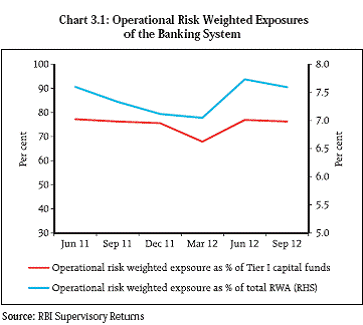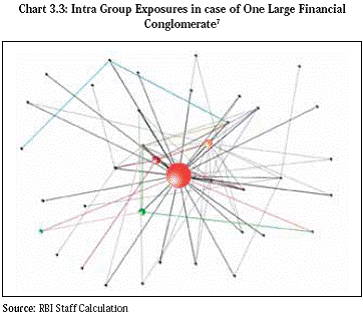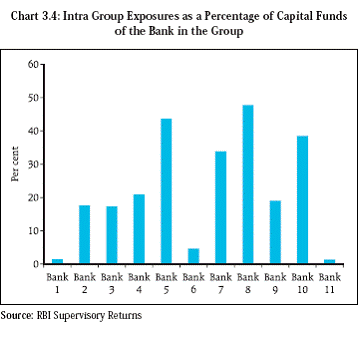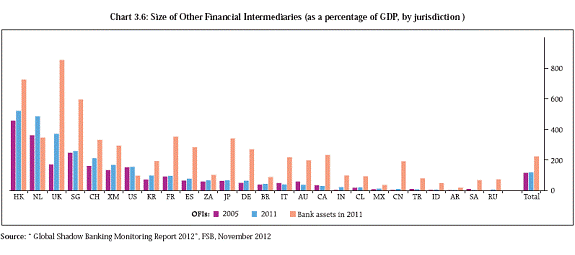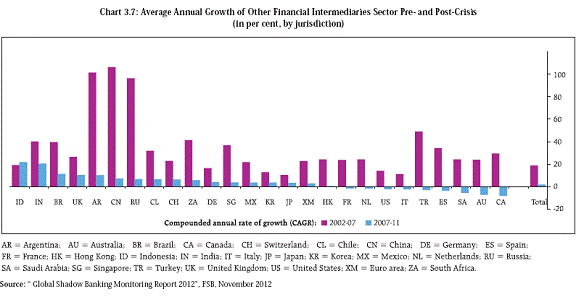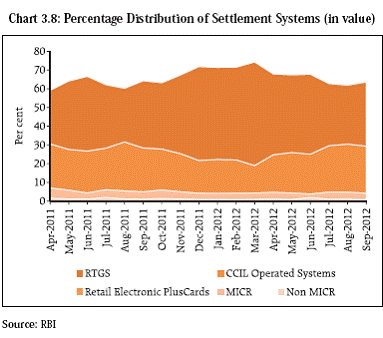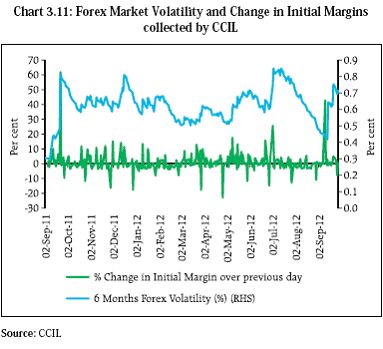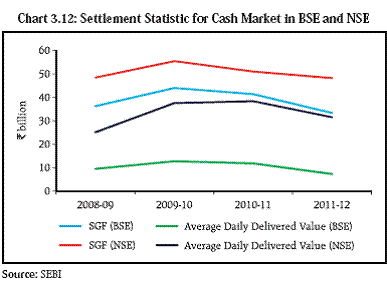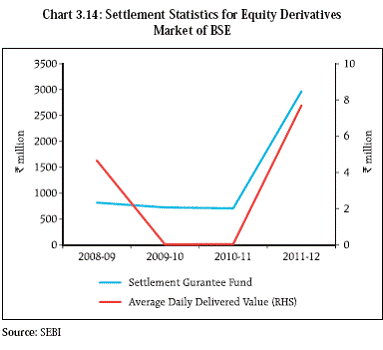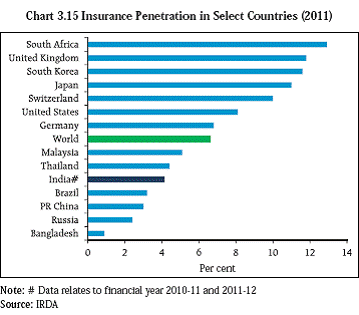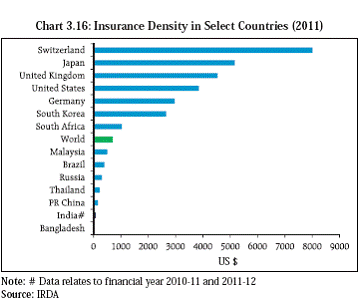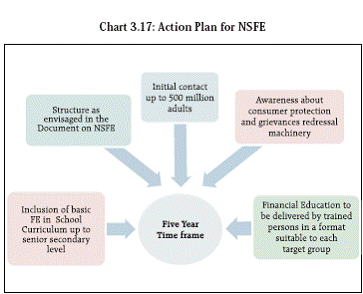 IST,
IST,
Chapter III : Financial Sector Regulation and Infrastructure
The global regulatory reforms agenda has largely crystallised. The focus is now on timely implementation. As a number of economies have announced their regulatory standards, concerns have emerged on the consistency of regulatory changes across jurisdictions. For emerging and developing economies (EDEs), there could potentially be negative consequences of the reform measures, especially from the extraterritorial nature of some reforms. Indian banks will face challenges as they migrate to Basel III given the declining asset quality and regulatory changes necessitating additional provisioning. Risks from the increased use of models, as banks migrate to advanced approaches under Basel II, will need to be managed. The identification metrics for Financial Conglomerates (FCs) will need to be fine tuned to take into account the work being done internationally for the identification of domestic systemically important banks (D-SIBs) and systemically important insurance companies and non-banking financial entities. The non-banking financial segment in the country is small relative to peer nations, but is growing at a faster pace. Gaps in the regulatory coverage of the non-banking financial sector will need to be progressively addressed. Significant progress is being made in the implementation of OTC derivative reforms in the country. Mandating or incentivising migration to guaranteed clearing will need that certain legal/ regulatory issues related to bilateral netting, exposure norms, etc. are addressed. Initiatives are being taken to address issues such as low coverage levels and delayed payments to depositors by the Deposit Insurance and Credit Guarantee Corporation (DICGC). Financial inclusion and literacy are tools to ensure growth with equity. Financially aware citizens make choices that strengthen financial system through greater use of financial products. This chapter also covers the efforts towards financial inclusion and literacy that the government and regulators have undertaken in the interest of financial stability. The aim of such efforts is to provide easy access to financial products and ensure that savings remain within the formal financial sector for productive deployment. Regulatory Infrastructure Implementation of Global Regulatory Reforms 3.1 In the wake of the financial crisis, an ambitious global reforms agenda focusing on major risks to the stability of the financial system was launched. The reform initiatives announced include the Basel capital and liquidity framework, policy measures for global systemically important financial institutions (G-SIFIs), over-the-counter (OTC) derivatives market reforms and strengthening the regulation and monitoring of the shadow banking system. The focus has now progressed from policy formulation to effective and timely implementation. 3.2 A progress report1 on the implementation of the Basel Committee recommendations observed that several member countries have missed the globallyagreed implementation dates for Basel II and 2.5. In case of Basel III, ten countries have published the final domestic guidelines. The Basel Committee is, however, hopeful that the remaining jurisdictions will finalise their domestic regulations during the year 2013. Implementation delays have also been observed in case of several other reform measures, e.g. implementing an effective resolution regime for G-SIFIs, convergence of accounting standards, reducing reliance on credit rating agencies and achieving the full implementation of the agreed reforms in the OTC derivatives market. At the implementation stage, some jurisdictions are finding it necessary to modify some of the regulatory prescriptions to ensure that transitions are non disruptive. 3.3 Consistency in the implementation of reforms has emerged as a key concern as several jurisdictions have come out with their own regulatory standards. A Basel Committee review of the implementation of domestic Basel III guidelines, for example, found inconsistencies in risk measurement approaches in some jurisdictions. Such differences could potentially lead to migration of financial sector activities to less regulated jurisdictions and/or to the shadow banking sector with stability implications for the global financial system. It is important to ensure that there is no disharmony between the regulations in different jurisdictions so as to avoid confusion and regulatory arbitrage, which would ultimately erode the credibility of the reforms process. Side-effects of Regulatory Reforms 3.4 Concerns have emerged about the unintended side effects of regulatory reforms. These might be significant in case of EDEs. It is important to ensure that financial intermediaries in EDEs are not placed at a relative disadvantage as the opportunities, risks and challenges they face are different. Also, EDEs may be adversely impacted if demanding regulatory standards lead to deleveraging by global financial institutions in these economies. The effects on EDEs may also be exacerbated by the extraterritorial2 nature of some reforms and extant regulations (Box 3.1). A recent report prepared by the Financial Stability Board (FSB) in coordination with the staff of the International Monetary Fund and the World Bank3, highlights the potential adverse impact of the implementation of the reform measures on emerging markets and developing economies. Capital Requirements of Banks under Basel III 3.5 India has issued the final guidelines on Basel III. The implementation of Basel III capital requirements will begin on January 1, 2013 and is expected to be completed by March 31, 2018. 3.6 Earlier FSRs have reported that banks in India will start from a position of strength in implementing the Basel III measures. Quick estimates place the additional capital requirement of banks on account of Basel III at ` 5 trillion, of which non-equity capital will be to the order of ` 3.25 trillion while equity capital will be to the order of ` 1.75 trillion4. Additional challenges could be posed by the recent trends in asset quality of banks, regulatory changes in restructuring guidelines and the proposed implementation of dynamic provisioning norms that may increase the provisioning requirements of the banking sector. The deterioration in the macroeconomic conditions could further add to asset quality pressures. Migration to Advanced Approaches under Basel II 3.7 The guidelines on internal ratings based (IRB) approach for computing credit risk capital charge; the standardised approach (TSA) and advanced measurement approach (AMA) for operational risk; and internal models approach (IMA) for market risk have been issued. While three banks have applied to the Reserve Bank for accreditation for migrating to IMA under market risk, 15 banks have applied for migrating to IRB approach for calculation of credit risk capital charge. Further, 12 banks have applied for migrating to TSA, and nine banks have given letter of intention for migration to AMA for calculation of operational risk capital charge. One bank has been granted approval for migrating to TSA on ‘parallel run’ basis. Applications of the remaining banks are at various stages of examination. 3.8 The migration to advanced approaches, however, comes with inherent challenges as the process hinges on the sophistication of risk management systems, processes and culture as well as the availability of data; tools; methodologies; and necessary expertise in banks. Box 3.1: Extraterritorial Implication of Regulations The focus on addressing systemic risk at both the domestic and international level has led to a new dimension in terms of regulatory initiatives – extraterritoriality of regulations. As national authorities embark on efforts to avoid importing risks in an interconnected world and protect their respective economies, regulators often take a broad view of their regulatory perimeter. This, on occasions, results in an overarching reach of regulations making them applicable to entities beyond the home jurisdiction. Extraterritorial application of regulations arise as legislation or regulation is developed at a national or regional level ahead of, or inconsistently with, a globally agreed standard. In addition to regulations prescribed by national authorities, there are some prescribed by multilateral organisations such as the Basel Committee on Banking Supervision (BCBS) or International Organisation of Securities Commissions (IOSCO), which are often a precursor to national regulatory initiatives. Despite efforts to ensure that global standards are adopted consistently across jurisdictions, national interests could take precedence as the transnational reach of certain recent regulations impinge on the sovereignty of other nations. Concerns are emerging about the potential costs of compliance requirements and the possibility of similar unilateral action by other countries leading to regulatory fragmentation. Some notable regulations with significant extraterritorial implications include: Foreign Account Tax Compliance Act (FATCA) The objective of FATCA is to identify tax evaders among American tax payers and is made applicable to any non-US 9 that holds or manages customers’ or affiliates’ money. The provisions require the foreign financial institutions (FFIs) and non-financial foreign entities (NFFEs) to enter into a compliance agreement with the US Treasury and identify and report US accounts annually. The regulation has a sweeping reach as it does not mandate that such institutions should have a presence in the US. It imposes extensive due diligence and compliance requirements on foreign entities and stringent withholding tax in case of non-compliance. In addition, the reporting requirements could potentially conflict with some data privacy laws outside the US. Margin requirements for OTC derivatives under the Dodd- Frank Rules The proposed rules impose significant margin requirements for certain OTC derivative transactions. The requirements would have direct extraterritorial effect as they are made applicable to all such transactions if the transactions take place in the US or if any of the counterparties is controlled in any way by a US entity. Solvency II Solvency II is a risk-based regulatory regime that will apply to insurance establishments in the European Union. The Solvency II directive recognises the fact that the insurance industry is a global industry and therefore allows the European Commission to decide about the equivalence of a third country’s solvency and prudential regime. Registration Requirements under Rule 15(a) of the Securities Exchange Act, 1934 (US) Rule 15(a) of the Securities Exchange Act provides that any person who induces or attempts to induce the purchase or sale of a security using mails or some other means of interstate commerce must register as a broker-dealer with the Securities and Exchange Commission (SEC), US. There is no explicit territorial limitation to this requirement of registration of broker-dealers and hence, the provision extends to foreign broker or dealers also. The Rule provides a limited set of exemptions to a foreign broker-dealer from the registration requirements. Due to the limited scope of such exemptions, the extant regulatory framework in the US does not permit solicitation and marketing of offshore equities in the US by any entity, unless such broker-dealer is registered with the SEC. This creates a significant challenge to the portfolio investments from the US in India particularly through the recently introduced Qualified Foreign Investors (QFI) scheme which allows foreign institutions as well as individuals to directly access the Indian securities market. 3.9 The advanced approaches under Basel II necessitate the use of complex internal models for the calculation of capital charge. Concerns have been raised that banks’ modelling approaches are being used to optimistically calculate risk weights resulting in portfolios of similar risk being assigned varying amounts of equity capital. The complexity and opacity of such models add to the difficulties in scrutinising and assessing the capital adequacy ratios. In a recent report, the Bank of England has voiced concerns about the use of models for the aggressive application of risk weights resulting in capital positions of banks being over-stated5. The Basel Committee is also evaluating the sources of material differences in risk weighted assets (RWAs) across banks in order to estimate the extent to which the differences are practice based rather than risk based and to assess whether the RWA calculations are consistent with the relevant Basel standards. The final report in this respect is expected in early 2013. 3.10 As an increasing number of banks migrate to advanced approaches, validation and accreditation exercise will assume significance (Box 3.2). Assessing Operational Risk Capital 3.11 Against the backdrop of the global financial crisis, several high profile cases of frauds in banks, mainly involving traders in global banks, have surfaced and raised concerns that operational risk is emerging as a prominent risk for the banking sector. There are recent instances of banks being penalised for operational failures, under-scoring the fact that failure to manage operational risk can be expensive. These developments have focussed attention on the quantum of operational risk capital maintained by banks. There are concerns that under the standardised approaches under Basel II, the quantum of operational risk capital maintained by banks is linked to its revenue rather than being calibrated to the magnitude of operational losses incurred by the firm. Operational risk is recognised as one of the most difficult risks to measure and, even under the advanced approaches, capital requirements for operational risk are likely to be underestimated. 3.12 In the Indian banking system, measuring the extent of operational risks poses formidable challenges given the lack of historical data on operational loss events. Time series data is available only for the incidence of frauds. An analysis of such data indicates that losses incurred due to the incidence of frauds are rising for Indian banks in recent quarters (Charts 3.1 and 3.2). Box 3.2 : Challenges in Relying on Internal Models for Calculation of Capital Charge Calculation of capital charge under the advanced approaches of Basel II places extensive reliance on internal models. However, concerns have emerged over the potential for adverse consequences from decisions based on incorrect or misused model outputs and reports. Model risk can lead to financial loss, poor business and strategic decision making, or damage to a bank’s reputation. The risks inherent in the use of model derived risk-sensitive weights are a case in point. Model selection or model calibration (particularly PD and LGD estimation) have been identified as potential drivers of RWA variation as the same asset gets rated differently by different banks, even within a jurisdiction. Some jurisdictions have issued comprehensive guidance on effective model risk management. The US Supervisory guidance on model risk management issued in April 2011 identifies “effective challenge” of models as the central principle for managing model risk. Effective challenge depends on a combination of incentives, competence and influence. Such challenge can come from an internal source, such as model experts in the compliance and risk, or internal audit function; or in the form of external source, like consultants. The Prudential Regulation Authority (PRA), UK, has also identified challenges in use of internal model for the purposes of calculating regulatory capital requirements and expects models used to calculate capital requirements to be “conservative”, failing which the PRA would call for adjustments to the model, or set capital floors. The European Insurance and Occupational Pensions Authority (EIOPA) in its consultation paper on guidelines for own risk and solvency assessment (ORSA), a Solvency II requirement, lays out detailed guidelines for firms using internal models. The paper calls for the ORSA process to consider whether the firm is exposed to any risks other than those addressed through the internal model and whether the internal model deals with the risks it covers appropriately. Challenges are also posed by the fact that models cannot account for all kinds of risks. This is testified to by the recent operational risk events which indicate that “the risk of loss from failures by people and bank processes” could be rising. These challenges are further accentuated in banks where processes are complex. Recent high profile events have under-scored the fact that flawed risk models – one form of operational risk – can be expensive. Complex models can also facilitate frauds by enabling concealment of losses and short circuiting of risk controls. Identification Metrics for Financial Conglomerates (FCs) 3.13 A framework for dealing with D-SIBs that complements the work done so far towards dealing with global systemically important banks (G-SIBs) has been finalised as part of the global reforms agenda6. The framework comprises a set of 12 principles that focus on the assessment methodology and the higher loss absorbency (HLA) requirement for D-SIBs. The assessment methodology is based on the potential impact of a bank’s failure on the domestic economy, which is determined in terms of bank-specific factors such as size, interconnectedness, substitutability/ financial institution infrastructure and complexity. The HLA requirement is expected to be met fully by Common Equity Tier1 (CET1) through an extension of the capital conservation buffer, in line with the treatment of the additional loss absorbency requirement for G-SIBs. 3.14 No Indian bank has been classified as a G-SIB. While, no specific mechanism for identification and monitoring of SIFIs/D-SIB presently exists in India, a mechanism for monitoring and oversight framework of FCs is in place since 2004-2005. An FC is defined as a cluster of entities belonging to a Group, if (i) any group entity coming under the jurisdiction of specified regulators and having a significant presence in the respective financial market segment; and (ii) the group having operations in at least one more financial market segment viz., bank, insurance company, mutual fund, NBFC (deposit taking), NBFC (non-deposit taking) and primary dealer. Significant presence in the respective financial market segment is defined in terms of asset base (for banks and non-deposit taking NBFCs), turnover (for insurance companies), deposit base (for deposit taking NBFCs) and assets under management (for mutual funds). 3.15 The current framework for identification of FCs is based only on the “size” of the financial sector entity. Little cognisance is taken of off balance sheet assets, payment system obligations, intra-financial sector transactions, etc. The operations of non-banking finance companies like housing finance companies are not considered as part of any market segment. Further, the identification metrics do not factor in the impact of failure of an entity on the financial system. This system of identification could give rise to ‘blind spots’ with the potential of both Type 1 (treating an entity as an FC when it is not an FC) and of Type 2 (not identifying a financial sector entity as an FC when it is an FC) errors.
3.16 Going forward, an indicator based approach for the identification of FCs will need to be developed. The framework will need to factor in the work of the Basel Committee for D-SIBs as well as ongoing FSB work related to identification of systemically important insurance companies and identification of systemically important non-bank financial institutions (other than insurers and financial market infrastructures). Some of these FCs of which the bank is the parent entity, are likely to be identified as D-SIBs. An Inter Regulatory Forum for monitoring FCs set up by the Sub-Committee of the Financial Stability Development Council (FSDC) is examining the related issues. Intra Group Transactions and Exposures (ITEs) 3.17 ITEs invoke supervisory concerns due to the possibility of regulatory arbitrage and risk concentrations within the Group. With different approaches to setting limits or defining concentrations in entities within a Group or where there are unregulated entities, the differences in requirements can result in regulatory arbitrage. ITEs could also lead to drain on capital and double or multiple gearing which could impinge adversely on the banking group. The presence of ITEs can potentially complicate the resolution of the regulated entities within a troubled or failing conglomerate (Chart 3.3). 3.18 In the Indian context, an analysis of the magnitude of intra group exposures as on June 30, 2012 in the case of 11 large banks (including some FCs) indicates that such exposures comprise a significant percentage of the capital funds of the banking company in some cases (Chart 3.4).
3.19 Keeping in view the risks posed by ITEs, the Reserve Bank has issued draft guidelines in August 2012 to ensure that banks maintain arms length relationship in their dealings with the Group entities. Both quantitative limits for the financial ITEs8 and prudential measures for the non-financial ITEs9 have been proposed so as to contain concentration and contagion risk arising out of ITEs. Recent amendments to the banking legislations granting powers of consolidated supervision will further equip the Reserve Bank to, inter alia, monitor such risks (Box 3.3). Subsidiarisation of Foreign Banks 3.20 The increasing complexity and interconnectedness of cross border banking groups, along with the absence of effective resolution regimes, has led to an emerging debate about the preferred cross-border banking structure, viz., “subsidiarisation” as opposed to foreign banks operating as branches in the host country. Different models/ combinations of cross border banking structures co-exist in different regions (Chart 3.5). 3.21 From the perspective of policymakers-both home and host authorities, subsidiarisation has important stability implications. Home authorities might prefer the subsidiary model when their banks expand into risky cross border business environments. Host authorities might also prefer the subsidiary model, because the problems of the parent would not be passed down to the affiliate. Potential down side risks may arise if subsidiaries promoted by foreign banks become dominant in the domestic financial system. Anecdotal evidence suggests that, in countries where such subsidiaries had a large presence, they tended to substantially curtail their operations or withdraw from the host country when there were adverse developments in their home country. In addition, setting up of subsidiaries will not necessarily ensure unconditional support from the parent bank.
Box 3.3: Banking Laws (Amendment) Bill, 2012 The Banking Laws (Amendment) Bill, 2012, has been passed by both houses of Parliament to amend the Banking Regulation Act, 1949, the Banking Companies (Acquisition and Transfer of Undertakings) Act, 1970, the Banking Companies (Acquisition and Transfer of Undertakings) Act, 1980 and to make consequential amendments in certain other enactments. The Bill empowers the Reserve Bank to ensure that banks are owned and managed by persons meeting fit and proper criteria. It gives powers to the Reserve Bank to supersede the Board of Directors of a banking company and appoint an administrator for a period of 12 months with the objective of preventing the affairs of any banking company being conducted in a manner detrimental to the interest of the depositors or any banking company or for securing the proper management of any banking company. The Bill also empowers the Reserve Bank to supervise banks on a consolidated basis including their subsidiaries and associate enterprises, to ring fence the banking entity in the group from contamination by associated financial and non financial entities. Further the amendment provides for setting up of a Depositors Education and Awareness Fund by taking over unclaimed funds lying in inoperative accounts for ten years or more with banks and utilise the same for promotion of depositors’ interests and for such other purposes as may be specified by the Reserve Bank. The Bill will also facilitate consolidation of co-operative banking sector and viable functioning of cooperative banks in a sound and healthy manner without detriment to the interests of the stakeholders. 3.22 The Reserve Bank released a Discussion Paper on Presence of Foreign Banks in India in January 2011. The paper proposes mandating the subsidiary form of presence (i.e. wholly owned subsidiary (WOS)) of foreign banks at the entry level itself under certain conditions and subject to certain thresholds. Foreign banks which enter as branches would also be mandated to convert to WOS once they meet the conditions/ thresholds or become systemically important. Convergence of Accounting Standards 3.23 The Ministry of Corporate Affairs (MCA), Government of India had announced that banks in India will transition to the International Financial Reporting Standards (IFRS) converged Indian accounting standards (Ind AS) with effect from April 1, 201310. The schedule was announced keeping in view the then proposed International Accounting Standards Board (IASB) timeline (June 2011) for finalisation of IFRS 9 and the implementation time required after the finalisation of a standard. However, the IASB has deferred the mandatory date of its new financial instruments standard (IFRS 9) from 2013 to 2015 and has issued an Exposure Draft in November 2012 proposing limited modifications to the previously finalised portion of IFRS 9 pertaining to classification and measurement of financial assets. Further, the US Financial Accounting Standards Board (FASB) has recently decided to explore a revised approach to impairment (loan loss provisioning) model that could differ from the IASB’s “three bucket” impairment model11. These developments at the international level have added to the complexity and uncertainty of the convergence process for domestic banks. Shadow Banking System 3.24 Considerable progress has been made globally towards the finalisation of the policy framework for strengthening the regulation of the shadow banking system and to mitigate potential systemic risks (Box 3.4). 3.25 The broad objective of the global reforms agenda is to ensure that the shadow banking system is subject to appropriate oversight which addresses the risks posed by the sector. The approach, however, recognises that, in many jurisdictions, the shadow banking system can play a useful economic role and lead to efficiency gains, for example, due to:
3.26 While the policy framework has been set out for regulating and monitoring the shadow banking system, the final recommendations are to be developed in a number of areas. The emergent policy framework will also need to remain vigilant to the strongly adaptive nature of the shadow banking system which constantly innovates to developments in the financial and regulatory landscape. Box 3.4: Strengthening Regulation of the Shadow Banking System12 The FSB has recently published a series of reports setting out recommendations for effective monitoring of the shadow banking sector. Banks’ interactions with shadow banking entities Since the crisis, a number of measures have been / are being implemented (through Basel 2.5 and Basel III) that aim to strengthen the resilience of the banking sector against some risks posed by shadow banks. These measures include increased capital requirements for banks’ exposures to resecuritisation and to financial institutions; enhanced internal capital adequacy assessment process for securitisation risk and enhanced disclosure requirements related to securitisation. Going forward, the Basel Committee is working towards making further refinements to the regulatory treatment of banks’ exposures to shadow banking entities including developing a large exposure regime and introducing a risk sensitive capital treatment for banks’ investment in the equity of funds. Money market funds (MMFs) Given the demonstrated potential for systemic risk among MMFs, especially among funds offering stable or constant net asset value (NAV) to their investors, policy recommendations have been issued which provide a basis for common standards for the regulation and management of MMFs across jurisdictions. The recommendations cover a range of issues including valuation, liquidity management, use of credit ratings, disclosures and use of repos. Other shadow banking entities Given the high degree of heterogeneity and diversity in business models and risk profiles across the non-bank financial space (other than MMFs), an economic functionbased (i.e. activities-based) perspective has been adopted to mitigate risks posed by these entities. A framework of five economic functions, as under, has been set out for the purpose:
Securitisation Since the crisis, many regulatory reforms, including reforms related to retention requirements and measures to enhance transparency and standardisation of securitisation products, have been undertaken to address the systemic vulnerabilities and incentive problems associated with securitisation. Further, possible policy actions have been identified towards convergence and enhanced monitoring of risk retention requirements, improving disclosures by issuers and encouraging standardisation of securitisation products. Securities lending and repos To address financial stability risks arising from practices in the securities lending and repos market, a series of policy recommendations are being developed. These encompass improved reporting to regulators and end-investors, improving transparency and disclosures, addressing risks associated with re-investment of cash collateral and with re-hypothecation of client assets, introducing minimum standards for haircut practices, strengthening collateral valuation and management practices, exploring the feasibility of establishing central clearing and addressing bankruptcy law treatment of securities lending and repo transactions. 3.27 In the Indian context, a Working Group on “Issues and Concerns in the NBFC Sector” set up by the Reserve Bank had made a series of recommendations to address issues relating to regulatory arbitrage and systemic risk, so as to create a strong and resilient nonbanking financial sector. Based on recommendations made by the Working Group, the Reserve Bank of India has, in December 2012, issued draft revised guidelines related to entry point norms, principal business criteria, prudential regulations, liquidity requirements for NBFCs and corporate governance. The draft guidelines have proposed ample transition time to bring the new regulatory framework into existence so as to ensure that the revised regulations are implemented in a non-disruptive manner. Growth Trends in the Non-Banking Financial Sector 3.28 In the Indian context, the ‘shadow banking system’, as it existed in much of the developed world is largely irrelevant as the regulatory perimeter of the country is relatively wide, encompassing most nonbanking financial entities. NBFCs are regulated by the Reserve Bank, while insurance companies and asset management companies are regulated by IRDA and SEBI respectively. 3.29 Over the years, the NBFC sector has seen a fair degree of consolidation, leading to the emergence of larger companies with diversified activities. There has been a gradual, regulation induced reduction in the number of deposit taking NBFCs from nearly 1500 in March 1998 to less than 300 currently. No new NBFC has been permitted to commence raising public deposits since 1997. 3.30 The size of the non banking financial sector, at 21 per cent of GDP, is relatively small compared to the global average. Post crisis, however, the growth rate of “other financial intermediaries13” has been relatively higher than peer economies including Mexico, Brazil, South Africa and China. While a part of the growth in this segment can be attributed to structural factors such as the financial deepening of the economy, the underlying trends will need to be closely monitored especially in view of the interdependencies between the banking and non-banking financial sector in the country, as discussed in Chapter II (Charts 3.6 and 3.7). Regulatory Coverage of the Non-Banking Financial Sector 3.31 There are, however, some gaps in terms of regulatory coverage and data availability in respect of the shadow banking system in the country. For instance,
3.32 Plugging the data gaps will be necessary for a holistic assessment of the size of the non banking financial segment in the country and of the systemic risks posed by the segment. To address these issues, a Working Group with representation from all the financial sector regulators is attempting to “macro map” the shadow banking sector in the country. Bancassurance 3.33 Banks account for a significant share in the distribution of products in the life insurance segment. IRDA issued, in October 2012, a revised exposure draft on bancassurance. The proposed regulations allow banks to sell insurance products by either becoming a broker or a corporate agent. Banks selling insurance products offer several benefits viz., it encourages customers of banks to purchase insurance policies and further helps in building better relationship with the bank; reach of insurance products could improve through the widely distributed networks and better marketing channels of banks; and the increased competition could facilitate better premium rates and services for the customer. However, as highlighted in the previous FSR, many instances of mis-selling of insurance products through this channel have been evidenced. The exposure draft seeks to leverage on the benefits of bancassurance while addressing the concerns of mis-selling through stipulations such as imposition of a ceiling on number of tie ups a bank can enter into as bancassurance agent, improved grievance redressal systems, prescription of a code of conduct and enhanced due diligence and compliance of KYC (Tables 3.1 and 3.2). 3.34 Several aspects of the exposure draft will need careful consideration. Extant regulations do not permit banks to become insurance brokers. Banks assuming the role of insurance brokers may also lead to conflict of interests where the bank is also the promoter of an insurance company. Further, some provisions of the exposure draft, if implemented, may expose the banks to reputational risks. Payment and Settlement Systems 3.35 The payment and settlement systems continued to function in a robust manner with increased usage of electronic modes of transaction settlement (Charts 3.8 and 3.9). Regular disaster recovery tests for large value payment systems testified to the robust arrangements in place for business continuity of such systems. 3.36 The Reserve Bank released its Payment Systems Vision Document for the three year period (2012-2015) in June 2012. The document reaffirms the Reserve Bank’s commitment towards providing safe, efficient, accessible, inclusive, interoperable and authorised payment and settlement systems for the country. Margin Movements in Foreign Exchange Settlements 3.37 The global financial crisis has brought to the fore the risks to financial stability posed by excessive procyclicality of the financial system which could amplify swings in the real economy and exacerbate market stress and volatility. In the case of OTC derivatives market, procyclicality could be caused by the correlation between changes in risk management practices (margins, haircuts) and business or credit cycle fluctuation. The margining policies of central counterparties (CCPs) and exchanges acquire particular importance in this context. CCPs impose margins in order to protect the systems from potential future losses arising from counterparty failures. But, if the assessment of potential future losses is based purely on volatility, there will be a sharp increase in margins if market volatility were to increase. Key considerations enunciated in the recently issued Principles for Financial Market Infrastructure14 on collateral and margins, emphasise the need to establish stable collateral and margining policies that reduce the need for procyclical adjustments.
3.38 An analysis of the trends in foreign exchange market volatility and margins collected by the Clearing Corporation of India Limited (CCIL) over the last one year provide some indications of procyclicality. CCIL’s stipulation of a minimum margin as part of its initial margin computation could, however, reduce the procyclicality impact to some extent. Recent refinements to the initial margin computation carried out by CCIL to reflect the increased volatility of forward premium in USD/INR foreign exchange market have resulted in significant increase in minimum margin requirements. This could further mitigate the adverse impact of such procyclicality. Nonetheless, the underlying trends in margins will need to be closely monitored (Charts 3.10 and 3.11).
3.39 The above issues are equally relevant for trading on exchanges. A recent assessment by SEBI found that initial margin prescriptions by CCPs for equity derivatives and currency futures trades were adequate to cover daily volatility of prices/exchange rates. The potential procyclicality, if any, of such margin prescriptions may also need to be assessed and monitored.
Exposure of Equity Market CCPs to Banks 3.40 Previous FSRs have discussed the interdependencies in the domestic payment and settlement systems. CCPs in the equity market accept margins/ contribution to the settlement guarantee fund (SGF) in the form of bank guarantees and securities (which may in turn be issued by banks) amongst others. This exposes the CCPs to credit risk vis-à-vis the banking sector. Prudential regulatory limits are in place to prevent excessive concentration of the CCPs to any one bank or to any particular class of banks. The exposure of the National Securities Clearing Corporation Limited (NSCCL) and the Bombay Stock Exchange (BSE) to the banking sector is well diversified with their exposure to the top five banks standing at 18.5 per cent and 24.1 per cent, respectively, of total exposure to the banking system. However, four banks are common in this list of top five banks for both NSCCL and BSE, indicating that any disturbance emanating from any one of these four banks could adversely impact both the CCPs concurrently (Table 3.3). Though the exposures of the CCPs to the banks are well within the prudential exposure limits prescribed by SEBI, the interconnectedness between the CCPs and banks needs to be monitored.
Settlement Guarantee Funds of Equity Clearing Corporations 3.41 “Owned funds” and the SGFs play a critical role in the risk management framework of a CCP which guarantees settlement of net obligations arising out of trades settled by it. The risk management framework of the CCP will therefore need to ensure that sufficient funds are available with it to meet the obligations of its members, including the member with the largest net debit position, should it default. In the case of equity clearing corporations in the country, the broad framework for risk management is prescribed by SEBI. 3.42 The funds/resources available to the CCP are typically employed in a hierarchical order in the case of a default by a member. For example, in the case of the NSCCL, the initial recourse is made to the margin contributed by the defaulting member and any contribution or deposit made by or bank guarantee arranged by the member to the SGF. If these funds are not sufficient, then other funds are sourced e.g. the amount of security deposit, if any, made by the defaulting member to the specified exchange; or the fines, penalties, interest on delayed payment, etc., if any, available with the CCP. Thereafter, the earnings of the CCP are used following which the amount of contribution and deposit made by all categories of clearing members to the SGF in proportion to the total contribution and deposit made by each clearing member are utilised. 3.43 An analysis of the SGF available with the major equity exchanges viz., NSE and BSE for cash and the derivatives segment indicates that, in most cases, the quantum of SGF is sufficient to cover the average daily delivered value. SEBI’s recent measures in mandating all stock exchanges to transfer 25 per cent of their profits to the SGF of the CCPs where their trades are settled, will further buttress the risk management framework of the CCPs (Charts 3.12 to 3.14).
Progress in OTC Derivative Reforms 3.44 In October 2012, the FSB published its fourth progress report on OTC Derivatives Market Reforms15. The Report points to substantial progress towards implementation of the agreed reform measures viz., electronic trading and/or central clearing of all standardised OTC derivative contracts by end- 2012; and reporting of OTC derivative contracts to trade repositories (TRs); imposition of higher capital requirements for non-centrally cleared contracts. However, it is now clear that the agreed deadline of end-2012 for full implementation of the reform measures will not be met. 3.45 The Report indicates, subject to limitations of data, that approximately 10 per cent of outstanding credit default swaps (CDS) and 40 per cent of outstanding interest rate derivatives were centrally cleared as of end-August 2012. It estimates that while transaction information on well over 90 per cent of OTC interest rate and credit derivative contracts is being reported to TRs, only around 50 per cent of foreign exchange derivative transactions are being reported. 3.46 Going forward, a number of challenges remain in achieving complete implementation of the OTC derivative reforms, especially in ensuring that all standardised OTC derivative transactions are cleared centrally (Box 3.5). Box 3.5: Challenges in Migrating to Central Clearing Globally, there is widespread acceptance of the broad objective that OTC derivative products have to migrate to central clearing. Within the ambit of this broad objective, however, there is recognition of the fact that only products meeting certain conditions can migrate to central clearing. In particular, the features of the product should facilitate management of the risks of the product by a CCP. These features include standardisation; relative lack of complexity in contract terms; sufficient market liquidity; and readily available pricing information. There is, thus, a need for careful assessment and definition of the product scope for mandatory migration to central clearing. There are also divergent views about the participants to be included under the mandatory central clearing requirement. Views have emerged that the mandatory central clearing requirements should apply only to participants which pose systemic risk and that exemptions/carve outs could be considered for smaller users of derivatives, especially nonfinancial entities. There are also fears that CCP clearing will result in exposures being concentrated in a small number of clearing banks leading to increased systemic risk in case of failure of a clearing member. A large number of operational issues are also arising. These include issues related to inter-operability across different CCPs in the same jurisdiction and across CCPs in different jurisdictions, cross margining and netting. Each of these issues may, in turn, change the risk profile of individual CCPs while potentially posing systemic risks, which will need to be assessed and managed. There are also concerns arising from legal complexity, regulatory uncertainties and inconsistencies, applicability of insolvency regimes and of the default management processes of CCPs and potential increase in collateral requirements. Yet another set of issues relate to cost considerations. On the one hand, substantial costs are likely to be incurred in providing for the technological and other resources for setting up CCP arrangements and for establishing links and interfaces. On the other, there is also a general consensus among market participants that central clearing is likely to increase the cost of dealing in OTC derivatives. There are fears that the regulatory changes being envisaged for the OTC derivatives market may result in the market itself getting impaired/killed in the medium to long run. There are views that benefits from central clearing are unlikely to accrue to market participants in the short run even though, in the long run, there are benefits in terms of increased market efficiency as well as lower risks of instability. Regulators around the world are, therefore, exploring the possibility of either mandating the migration to central clearing or incentivising it, or both. The Basel III capital rules, for example, will create an incentive to move to central clearing because exposures to a CCP will generally attract a lower capital charge than other bilateral exposures. It is also clear that implementation of the G20 reform measures will increase concentration risks vis-à-vis the CCPs. It will, thus, be critical to ensure the compliance of CCPs with the four “safeguards” identified by the FSB for a resilient and efficient framework for central clearing: (i) fair and open access by market participants to CCPs, based on transparent and objective criteria; (ii) cooperative oversight arrangements between all relevant authorities, both domestic and international, that result in robust and consistently applied regulation and oversight of global CCPs; (iii) resolution and recovery regimes that ensure the core functions of CCPs are maintained during times of crisis and that consider the interests of all jurisdictions where the CCP is systemically important; and (iv) appropriate liquidity arrangements for CCPs in the currencies they clear. 3.47 With regard to margin requirements for noncentrally cleared derivative transactions, there are concerns that the greater collateralisation of such transactions may, in turn, lead to new risks. Margin requirements on non-centrally cleared derivative transactions will mitigate counterparty risks but the underlying collateral may by itself be a source of credit and liquidity risks. There are also concerns about the systemic implications of increased collateral requirements, especially at a time when other regulatory reforms (e.g. Basel III) will also impose demands on similar high quality, liquid collateral. 3.48 Significant progress has been made in implementing the OTC derivative reform measures in the domestic economy. In July 2012, a Trade Repository (TR) for OTC derivative product was launched and, in two phases, reporting of all major foreign exchange OTC derivatives to the TR has commenced. These arrangements will be extended, in phases, to cover foreign currency OTC derivative trades between banks and their clients under a suitable protocol to ensure confidentiality of client trades as also interest rate derivative products including client trades in rupee interest rate swaps (IRS). 3.49 Following the recommendations of the Working Group on Enhancing Liquidity in the Government Securities and Interest Rate Derivatives Markets16, it has been decided to standardise IRS contracts to facilitate centralised clearing and settlement of these contracts. 3.50 Infrastructure for the central clearing and guaranteed settlement of foreign exchange forward transactions in the US dollar / Indian rupee segment from the trade date to the settlement date has been in place since December 2009 for inter bank transactions. IRS and forward rate agreements (FRA) in the Indian rupee, which form the bulk of interest rate derivative transactions in the country, are currently being centrally cleared in a non-guaranteed mode. Though, it is not mandatory for market participants to clear their trades through CCP, more than 70 per cent of IRS trades are cleared through CCP. 3.51 Guaranteed clearing of foreign exchange forward transactions in the US dollar / Indian rupee segment has been mandated and the migration of transactions in this segment to guaranteed clearing is likely to commence shortly. An “in principle” decision to bring IRS and FRA transactions in the Indian rupee within the ambit of guaranteed settlement has been taken. The risk management framework and procedural aspects proposed by the central counterparty are currently being examined. 3.52 Mandatory guaranteed clearing will result in the exposures of banks, which are currently spread across a large number of counterparties, being concentrated against the central counterparty. These exposures are required to be calculated using the current exposure method (the sum of gross positive MTM and potential future credit exposure) and will be subject to the extant exposure limits which prescribe a single borrower exposure limit of 15 per cent of the capital funds of the bank. Mandating settlement of a larger number of derivative products through CCIL is, thus, likely to result in banks’ exposures vis-à-vis CCIL breaching the single borrower limit. Given the general consensus that migration to guaranteed clearing will increase settlement costs for participants, incentivising banks to move to guaranteed clearing in the Indian context may also be difficult. 3.53 Several options could be explored for addressing these issues viz., designing a suitable exposure framework for CCIL which addressed the issue of the single borrower limit; taking recourse to the provisions of the Payment and Settlement Systems Act, 2007 (which defines netting and provides legal recognition for the procedures adopted by the system operator provided the same are approved by the Reserve Bank when it authorises such a system) to permit netting of exposures for capital calculations; examining setting up of additional CCPs; etc. CCIL’s eligibility to be treated as a qualified CCP under the new framework issued by the Basel Committee which provides for concessional capital treatment to bank exposures to qualified CCPs would also need to be examined in this connection. Safety Net Arrangements 3.54 The global financial crisis illustrated the importance of effective depositor protection arrangements and also revealed several weaknesses in extant depositor protection systems. As an immediate response to the financial crisis, several countries increased their insurance coverage limits and some even extended blanket deposit guarantee as a temporary measure. Many countries are overhauling the design of deposit insurance system to be able to make quick payout arrangements by improving access to depositor information on the lines of single customer view of deposits as in the US. In several countries, initiatives are underway towards making deposit insurance an integral part of the safety net framework. The initiatives are primarily aimed at ensuring the proactive and early involvement of deposit insurance agency in resolution of weak/ failing banks. 3.55 Several issues, as under, pertaining to deposit insurance in India have been highlighted in previous FSRs: (i) The coverage levels were low by international standards and have remained unchanged since May 1993. The DICGC has submitted a proposal to the Government of India for increasing the cover. (ii) DICGC provides insurance cover to a heterogeneous range of banks whose failure rates differ. However, as premium is being charged at a uniform rate, this leads to cross-subsidisation and raises moral hazard issues. As the risk-based rating system has not evolved in India, it may be difficult to migrate to risk-based premiums. DICGC is, however, considering implementing a differential premium system based on available supervisory ratings. (iii) DICGC has been facing delays in obtaining depositor information from the liquidators of failed co-operative banks, thus leading to delays in making payments to depositors. It has also been observed that some liquidators were not prompt in making payment to depositors after the claim was settled by DICGC. Both these have led to delays in making payments to depositors. In order to resolve the problem, DICGC has initiated steps to make direct payment to depositors and for expediting reimbursement to depositors along with technology upgradation. (iv) A bank resolution framework is yet to evolve in India. The legal framework governing bank resolution is spread over a large number of laws and regulations, making the framework complex and non-transparent. A high level Working Group set up by the Sub Committee of the FSDC is examining the related issues. Financial Stability and Development Council (FSDC) 3.56 The FSDC and its Sub Committee continued to provide focussed attention to potential risks to financial stability including, inter alia, the risks from a potential downgrade of the country’s rating; the concerns arising from the elevated demand for gold in the country; and the external sector vulnerabilities of the country. The Sub Committee commenced work towards setting up an effective mechanism for the monitoring of FCs and putting in place an effective resolution regime for all financial institutions in the country. Significant initiatives towards greater financial inclusion and literacy were set in motion by the Sub Committee, as discussed in paragraph 3.78. Product Innovations in India 3.57 Financial innovation is not an end in itself, but instead, a means to an end of sub-serving the real sector and in that sense it is consistent with, and a natural fit to, public policy purpose of “financial sector-real sector balance”. It was the unsustainable “financial sector-real sector imbalance” due to certain financial innovations that was the real cause of the last global financial crisis17. Opacity and complexity of OTC derivatives have time and again raised concerns on suitability and appropriateness of the products sold in the market. 3.58 In India, most of the innovations in the market have been spearheaded by the regulators in their efforts to develop the markets and also ensure consumer protection. New products in derivative segments in equities, foreign exchanges etc. have been well received, and market volumes and widespread usage are indicative of this. The bid-offer spreads also indicate that liquidity in these markets is reasonably high. 3.59 In this context, an analysis was undertaken into the reasons for the skewed response to some of the interest rate derivative products introduced in the Indian markets. Interest Rate Swap (IRS), in India, is primarily used by a narrow set of foreign banks. Returns filed by banks reveal that trades with corporates constitute about 3 per cent of total turnover of the IRS market. 3.60 The fixed rates of 2-year and 5-year IRS (predominantly Overnight Indexed Swaps) reflect the participants’ view of the future path of overnight interest rates in India18. That is why trading activity increases ahead of monetary policy announcement dates, particularly when the markets are uncertain about the rate move by the Reserve Bank. It tends to fall within a day or two of the announcement after squaring off of positions by traders. IRS is not liquid beyond 5-year maturity and most of the trading activity is concentrated in the 1-year. IRS was introduced with the objective of providing a tool for hedging interest rate risk of bonds (invested or issued). The largest issuers of bonds in India are public sector banks and NBFCs and 10-year maturity is a popular segment. This suggests that IRS is not used by clients to hedge their bond issuances or investments. Moreover, bonds in India, unlike in advanced countries, are not priced as a spread over swap rates. Banks price their loans to borrowers as spreads over their respective base rates which depend on their cost of funds and do not incorporate government bond or treasury bill yields. This creates a wedge between IRS and government bond yields. In fact, swap rates are often lower than that of government bond yields of comparable maturity. 3.61 Interest Rate Futures (IRF) contract was first introduced in 2003 for the 10-year sector. It received a poor response and a committee headed by Shri V.K.Sharma, Executive Director, the Reserve Bank of India, looked into product features that are best suited for Indian conditions. The reintroduced product also has not fared much better. Interaction with market participants indicates that this could be because neither the banks nor the borrowers find the product as an effective hedge, since their exposures are to the Base Rate which is not currently having any link to the underlying rate of the IRF. Banks (which hold around 37 per cent), Insurance companies (around 22 per cent), the Reserve Bank (around 13 per cent) and Provident Funds (around 7 per cent) together hold four-fifths of the outstanding government bonds and do not require marking-to-market. One more reason for lower interest, according to market participants, is the relatively restricted regulatory regime for shorting of securities. Cash-and-carry arbitrage strategies, which often provide volumes to the market are rare. The IRF, as a result, failed to provide liquidity to bonds in the deliverable basket. There is a fear among participants that they will have to take delivery of the Cheapest- To-Deliver (CTD) security in the deliverable basket, typically a very illiquid one. Regulatory Initiatives for Financial Inclusion and Financial Stability 3.62 Financial Inclusion is the process of ensuring access to appropriate financial products and services needed by all sections of the society in general and vulnerable groups such as weaker sections and low income groups in particular, at an affordable cost in a fair and transparent manner by regulated mainstream institutional players. Globally, the triad of Financial Inclusion, Financial Literacy and Consumer Protection has been recognized as intertwining threads in pursuit of Financial Stability. For any kind of stability, whether financial, economic, political or social, inclusive growth is an essential prerequisite. Inclusive growth, in turn, is largely driven by financial inclusion and an inclusive financial system. Financial Inclusion and financial literacy are complementary to each other. For EDEs, ensuring adequate access to financial products and services is important at their current stage of development. The lack of easy access to financial products creates demand for non-financial products like gold and real estate19. Financial literacy creates demand for financial products and services and thus encourages a more sustainable growth of the financial sector. Reserve Bank of India 3.63 The Reserve Bank is furthering financial inclusion through a combination of strategies ranging from relaxation of regulatory guidelines (e.g. simplified Know Your Customer (KYC) norms), provision of new products and other supportive measures to achieve sustainable and scalable financial inclusion. It has a structured and planned approach to financial inclusion wherein all banks have prepared Board approved Financial Inclusion Plans (FIPs) with a three year horizon extending up to 2013. The initial goal of providing access to banking services in all villages with population more than 2000 by March 2012 has been successfully met and the focus now has shifted to providing banking services for all the other villages in a time bound manner. The focus now is more on the volume of transactions in new accounts opened as a part of the financial inclusion drive. 3.64 India has adopted a bank-led model for financial inclusion which seeks to leverage on technology. The financial inclusion initiatives would have to be Information and Communication Technology (ICT) based and would ride on new delivery models that would need to be developed by the market participants to best suit their requirements. Experience shows that the goal of financial inclusion is better served through mainstream banking institutions as only these institutions have the ability to offer the suite of products required to bring in effective/meaningful financial inclusion. Other players such as mobile companies have been allowed to partner with banks in offering services collaboratively. 3.65 To meet the criterion of availability of banking services, banks have been advised to offer a minimum of four basic products to customers, viz. a basic savings bank deposit account with emergency credit facility like overdraft; a remittance product for Electronic Benefit Transfer and other remittances; a pure savings product such as a recurring deposit or a variable recurring deposit and facility of entrepreneurial credit such as General Credit Card and Kisan Credit Card. In order to further strengthen the ongoing financial inclusion agenda in India, a high level Financial Inclusion Advisory Committee has been constituted by the Reserve Bank. The Committee would pave the way for developing a viable and sustainable banking services delivery model focusing on accessible and affordable financial services, developing products and processes for rural and urban consumers presently outside the banking network and for suggesting appropriate regulatory framework to ensure that financial inclusion and financial stability move in tandem. 3.66 The Reserve Bank has been spearheading financial inclusion efforts through credit allocation norms mandating scheduled commercial banks to lend to the priority sector. More recently, the Reserve Bank had set up a Committee to re-examine the existing classification of priority sector lending and suggest revised guidelines with regard to priority sector lending classification and related issues (Chairman: Shri M. V. Nair). Based on the Committee’s report and suggestions/ comments received from various stakeholders, the guidelines on priority sector lending were revised by the Reserve Bank on July 20, 2012. In terms of the revised guidelines, foreign banks with 20 or more branches have been brought at par with the domestic commercial banks in terms of the target/ sub-targets under priority sector lending to 40 per cent from 32 per cent of Average Net Bank Credit or Credit Equivalent amount of Off Balance Sheet Exposures, whichever is higher, as on March 31 of the previous year. Lead Bank Scheme 3.67 To ensure provision of banking services across India especially in rural areas, the lead banks (under the Lead Bank Scheme) were advised to draw up a roadmap to provide banking services through a banking outlet in every village having a population of over 2000. Under the roadmap, out of 74,414 such unbanked villages identified and allotted to various banks (public sector, private sector and Regional Rural Banks (RRBs)), banking outlets have been opened in 74,199 villages as on March 31, 2012, comprising 2493 branches, 69374 Business Correspondent (BC) and 2332 through other modes like rural Automated Teller Machines (ATMs), mobile van, satellite branch, etc. Banks are being encouraged to start with Electronic Benefit Transfer (EBT) services. The objective is to provide a bank account to every household/person throughout the country. Hence, banks should endeavour to have a BC touch point in each of the villages in the country, to start with, through provision of EBT services, at least once a fortnight to facilitate transfer of all State benefits including Mahatma Gandhi National Rural Employment Guarantee Act (MGNREGA) wages and various cash subsidies to beneficiaries by direct credit to the bank accounts. 3.68 In order to enhance the penetration of banking services in Tier 2 centres (with population of 50,000 to 99,999 as per Census 2001), RRBs have been permitted to open branches in Tier 2 centres on par with the policy for Tier 3 to 6 centres i.e without the need to take approval from the Reserve Bank subject to certain conditions. Financial Inclusion Plan of banks 3.69 A major initiative taken by the Reserve Bank in January 2010 was that all public and private sector banks were advised to submit a Board approved threeyear Financial Inclusion Plans (FIPs) starting April 2010. Banks were advised to devise FIPs congruent with their business strategy and comparative advantage to make it an integral part of their corporate business plans. Banks were advised to integrate the Board-approved FIPs with their business plans and to include the criteria on financial inclusion as a parameter in the performance evaluation of their staff. The implementation of these plans is being closely monitored by the Reserve Bank through quantitative and qualitative reporting and review meetings with Chairman and Managing Director s and other senior officials of banks. 3.70 A snapshot of the progress under FIP for the period March 2010 to September 2012 is in Tables 3.4 and 3.5. The number of transactions through ICT based BC outlets, though encouraging, are still very low as compared to the manifold increase in the number of banking outlets. The focus of monitoring is now more on the number and value of transactions in no-frills accounts and also on the credit disbursed through ICT based BC outlets. In this direction, banks have been advised that FIPs prepared by their head offices are disaggregated at respective controlling offices and further at the branch level and the progress monitored periodically.
Insurance Regulatory and Development Authority (IRDA)20 3.71 For access to insurance products, the vast network of insurance offices including micro or oneman offices reaching out to several towns and villages is a pointer to the availability of sales touch points in smaller places. With a view to ensuring special attention to the rural, economically and socially vulnerable segments of the population, the IRDA (Rural and Social Obligations) Regulations cast obligations on Insurers to cover these segments under insurance. 3.72 The potential and performance of the insurance sector is universally assessed in the context of two parameters, viz., Insurance Penetration21 and Insurance Density22 (Charts 3.15 and 3.16). The Insurance Penetration was 2.32 (Life 1.77 and Non-life 0.55) in the year 2000 when the sector was opened up for private sector, and has increased to 4.10 in 2011 (Life 3.4 and Non-life 0.7). The insurance density in India was US$9.9 in 2000 which has increased to US$59 in 2011 (Life 49 and Non-life 10). For the year 2011- 12, more than 31 per cent of the total life insurance policies were issued in rural areas. In non-life sector, a business of ` 74.7 billion which constitutes 14.1 per cent of total non-life insurance business was generated from rural areas. 3.73 IRDA has pioneered the issuance of Micro Insurance Regulations which encourage simple and low ticket premium products covering the risks of life as well as livelihood. Many categories of individuals and entities that were considered by the Reserve Bank to act as BCs are under consideration of IRDA for according Micro Insurance Agency eligibility, with a few exceptions. Further a number of District Cooperative Banks, Regional Rural Banks and urban co-operative banks that are working in rural and semi urban areas are also being considered for permitting to act as Micro Insurance Agents. In addition to one Life Insurance Company and one General Insurance Company, a Micro Insurance Agent is now proposed to be permitted to work with Agriculture Insurance Company of India Ltd for the limited purpose of distributing crop insurance. The proposed modified regulations also entitle the individual insurance agents, who were already licensed to act as insurance agents, in rural areas where population is not more than 2000, to the higher percentage of Micro Insurance Remuneration. Further, it is also proposed to link the higher remuneration / commission rates payable on Second and Subsequent years’ premium to the persistency rate of Micro Insurance business portfolio of Micro Insurance Agent so as to encourage and emphasize on the quality of business.
3.74 As regards the scope of Micro Insurance Products, in the existing regulations, non life Micro Insurance (MI) products are covering retail risks faced by individuals. They do not address the institutional risks faced by Micro, Small and Medium enterprises that are playing a significant role in the country’s growth. Therefore, a proposal is under consideration that General (Non Life) Insurance policies issued to Micro, Small and Medium Enterprises as defined in Section 7 of Micro, Small and Medium Enterprises Development (MSMED) Act, 2006 under various classes of non-life insurance business will be qualified as non-life micro insurance business up to a premium of ` 25000 per annum per policy. However, the non life insurance companies will have enough discretion to decide whether to appoint MI Agents, if so to which sector / enterprises of MSME Sector. Pension Fund Regulatory and Development Authority (PFRDA) 23 3.75 Old age protection is an essential part of the social security needs of the unorganized sector and should form an important welfare goal. Introducing a Defined Contribution pension scheme (NPS-Swavalamban) for the unorganized sector workers enabling them to save small amounts during their productive years with a co-contribution from the government is an important step in achieving old age income security. Not only does the scheme enable aggregation of small savings, it also helps the government in limiting its liability and projecting the funding requirement. A number of countries such as Mexico, Vietnam run such cocontributory pension schemes. Securities and Exchange Board of India(SEBI) 24 3.76 SEBI is furthering financial inclusion via a number of measures. With a view to achieve wider financial inclusion, encourage holding of demat accounts and to reduce the cost of maintaining securities in demat accounts for retail individual investors, SEBI has decided that all depository participants (DPs) shall provide a “Basic Services Demat Account” (BSDA) with limited services, which will not charge any fee upto holding worth of `50,000/- and nominal charge of `100/- upto holding of `2,00,000/-. In order to encourage participation of small investors (who may not be tax payers and may not have Permanent Account Number (PAN)/bank accounts, the KYC requirement (such as PAN, Bank A/c’s etc.) has been relaxed for the investment upto `20,000 per investor, per mutual fund, per financial year subject to certain conditions. In order to encourage distribution of Mutual Fund products to semi-urban and rural areas, additional Total Expense Ratio (TER) upto 30 basis points has been allowed to be charged if net flows from beyond 15 cities are at least 30 per cent of gross new inflows / 15 per cent of assets under management. Other measures such as increasing the category of persons to be employed as mutual fund distributors have been undertaken to improve mutual fund penetration in rural and semi-urban areas. 3.77 SEBI has initiated a multipronged approach to spread financial literacy all over India. Investor Awareness Programs/ Workshops are organized for educating investors and to spread awareness. Regional Seminars are conducted in association with various exchanges, depositories and trade bodies. The objective of such seminars is to reach out to more people and concentrating primarily on tier 2 and tier 3 cities. SEBI continues its association with Investor Associations (IA) as well as Exchanges, Depositories and various trade bodies etc. It has launched a financial education drive through Resource Persons (RPs). The program aims at imparting understanding of financial concepts to the targeted groups. These empanelled RPs also supplement the investor education programs that are conducted through investor associations. A Pocket Money Program for school students jointly with National Institute of Securities Market is positioned as an important life skill at the school level (including municipal schools) targeting mainly 8th and 9th standard students. National Strategy on Financial Education (NSFE) 3.78 A draft document on the NSFE has been prepared under the aegis of the Technical Group on Financial Inclusion and Financial Literacy, set up by the Sub Committee of the FSDC. The draft Strategy seeks to create a financially aware and empowered India. The Technical Group had constituted a Sub Group to draft the NSFE for India. The Strategy prepared by the Group envisages ways towards creating awareness and educating consumers on access to financial services; availability of various types of products and their features; changing attitudes to translate knowledge into responsible financial behaviour; and making consumers of financial services understand their rights and obligations. The Strategy calls for active involvement of individuals, financial sector regulators, educational institutions, NGOs, financial sector entities, multilateral international players and the Government at both the Centre and the States. The Strategy envisages a time frame of five years for its financial education campaign (Chart 3.17). 3.79 The draft NSFE was placed in the public domain by all the financial regulators for public consultation in August 2012. Currently, the Technical Group is finalising the Strategy and drawing up a road map for its implementation.
1 http://www.bis.org/press/p121029.htm 2 Extraterritoriality is the application of a local regulatory requirement (whether licensing or transactional) to firms or market participants beyond the jurisdiction enacting it, or imposition of substantive compliance, or reporting burdens of such requirements outside the enacting jurisdiction. 3http://www.financialstabilityboard.org/publications/r_120619e.pdf 4 “Basel III in International and Indian Contexts Ten Questions We Should Know the Answers For”, Inaugural Address by Dr. Duvvuri Subbarao, Governor, Reserve Bank of India at the Annual FICCI - IBA Banking Conference at Mumbai on September 04, 2012. 5 Bank of England Financial Stability Report, November 2012 6 http://www.bis.org/publ/bcbs233.htm 7 The chart represents the exposures (fund and non-fund based between different group companies of a financial conglomerate as on June 30, 2012). The balls in the chart represent the group companies (with the red ball centre representing the banking company in the FC) while the lines represent the exposures. The size of the balls represents the share of the entity in total intra group exposures of the FC. 8 Financial ITEs are those whose outcomes can be associated with financial flows manifesting in the form of assets, liabilities and/ or revenue transactions. Examples of financial ITEs are fund-based and non-fund based transactions. 9 Non-financial ITEs refer to operations arising out of ‘matrix’ management facilitating control/ effective risk management over a business segment or a line of activity across a number of legally independent entities. Examples of non-financial ITEs are back-office arrangements, cross selling of products, etc. 10 In February 2011, the MCA published 35 IFRS converged Indian Accounting Standards (Ind AS) stating that their implementation date would be notified later after resolving all issues including those relating to taxation. Subsequently, there has been no further announcement from the MCA on the implementation date. Consequently, entities that were scheduled to transition to IFRS from April 1, 2011 and April 1, 2012, as per the MCA’s Roadmap, have not done so. 11 The IASB impairment model places financial assets into three categories (or ‘buckets’) for the purpose of assessing the timing of recognition of expected losses. The impairment loss recognised would vary depending on which category an asset is allocated to. Generally, 12 months of expected losses are recognised for financial assets placed in the first bucket with life time losses recognised on transfers to buckets 2 and 3. However, the finer details of the impairment model are still being deliberated by the IASB and an Exposure Draft on impairment is expected only in 2013. 12 Strengthening Oversight and Regulation of Shadow Banking: An Integrated Overview of Policy Recommendations”, Financial Stability Board, November 2012 13 As defined in the FSB report, “Global Shadow Banking Monitoring Report 2012”, November 2012, “Other Financial Intermediaries” include “NBFIs that cannot be categorised as insurance corporations or pension funds or public sector financial entities”. In the Indian case, this primarily refers to the NBFC sector and the liquid mutual funds. 14 http://www.bis.org/publ/cpss101.htm 15 http://www.financialstabilityboard.org/publications/r_121031a.pdf 16 The Working Group on Enhancing Liquidity in the Government Securities and Interest Rate Derivatives Market (Chair: R. Gandhi, Executive Director, Reserve Bank of India) submitted its report in August 2012 (/en/web/rbi/-/publications/reports/report-of-the-working-group-on-enhancing-liquidity-in-the-government-securities-and-interest-rate-derivatives-markets-677 ) 17 Sharma, V.K. (2012), “The Financial Innovations That Never Were ”, Keynote Address delivered at Finnoviti 2012 organised by Banking Frontiers, on November 8, 2012, Mumbai.18 They are the market’s neutral view about the Reserve Bank’s policy rate and its ability to influence the call rate. 19 Chapter I has discussed the issue of higher non-financial savings in the country vis-à-vis financial savings in the household sector. 21 Insurance penetration is defined as the ratio of premium underwritten in a given year to the GDP. 22 Insurance density is defined as the ratio of premium underwritten in a given year to the total population (measured in US$ for convenience of comparison). |
||||||||||||||||||||||||||||||||||||||||||||||||||||||||
পেজের শেষ আপডেট করা তারিখ:






